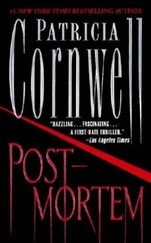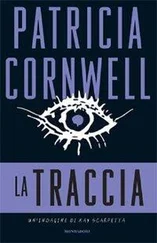Patricia Cornwell - Postmortem
Здесь есть возможность читать онлайн «Patricia Cornwell - Postmortem» весь текст электронной книги совершенно бесплатно (целиком полную версию без сокращений). В некоторых случаях можно слушать аудио, скачать через торрент в формате fb2 и присутствует краткое содержание. Жанр: Фантастика и фэнтези, на английском языке. Описание произведения, (предисловие) а так же отзывы посетителей доступны на портале библиотеки ЛибКат.
- Название:Postmortem
- Автор:
- Жанр:
- Год:неизвестен
- ISBN:нет данных
- Рейтинг книги:3 / 5. Голосов: 1
-
Избранное:Добавить в избранное
- Отзывы:
-
Ваша оценка:
- 60
- 1
- 2
- 3
- 4
- 5
Postmortem: краткое содержание, описание и аннотация
Предлагаем к чтению аннотацию, описание, краткое содержание или предисловие (зависит от того, что написал сам автор книги «Postmortem»). Если вы не нашли необходимую информацию о книге — напишите в комментариях, мы постараемся отыскать её.
Postmortem — читать онлайн бесплатно полную книгу (весь текст) целиком
Ниже представлен текст книги, разбитый по страницам. Система сохранения места последней прочитанной страницы, позволяет с удобством читать онлайн бесплатно книгу «Postmortem», без необходимости каждый раз заново искать на чём Вы остановились. Поставьте закладку, и сможете в любой момент перейти на страницу, на которой закончили чтение.
Интервал:
Закладка:
She was nude. On the colorful rag rug to the right of the bed was her pale yellow cotton gown. It was slit from collar to hem, and this was consistent with the three previous cases. On the night stand nearest the door was a telephone, the cord ripped out of the wall. The two lamps on either side of the bed were out, the electrical cords severed from them. One cord bound her wrists, which were pinioned at the small of her back. The other cord was tied in a diabolically creative pattern also consistent with the first three cases. Looped once around her neck, it was threaded behind her through the cord around her wrists and tightly lashed around her ankles. As long as her knees were bent, the loop around her neck remained loose. When she straightened her legs, either in a reflex to pain or because of the assailant's weight on top of her, the ligature around her neck tightened like a noose.
Death by asphyxiation takes only several minutes. That's a very long time when every cell in your body is screaming for air.
"You can come on in, Doc," the officer with the video camera was saying. "I've got all this on film."
Watching where I walked, I approached the bed, set my bag on the floor and got out a pair of surgical gloves. Next I got out my camera and took several photographs of the body in situ. Her face was grotesque, swollen beyond recognition and a dark bluish purple from the suffusion of blood caused by the tight ligature around her neck. Bloody fluid had leaked from her nose and mouth, staining the sheet. Her straw-blond hair was in disarray. She was moderately tall, no less than five foot seven, and considerably fleshier than the younger version captured in the photographs down the hall.
Her physical appearance was important because the absence of a pattern was becoming a pattern. The four strangling victims seemed to have had no physical characteristics in common, not even race. The third victim was black and very slender. The first victim was a redhead and plump, the second a brunette and petite. They had different professions: a schoolteacher, a freelance writer, a receptionist, and now a physician. They lived in different areas of the city.
Fetching a long chemical thermometer from my bag, I took the temperature of the room, then of her body. The air was 71 degrees, her body 93.5. Time of death is more elusive than most people think. It can't be pinned down exactly unless the death was witnessed or the victim's Timex stopped ticking. But Lori Petersen had been dead no more than three hours. Her body had been cooling between one and two degrees per hour, and rigor had started in the small muscles.
I looked for any obvious trace evidence that might not survive the trip to the morgue. There were no loose hairs on the skin, but I found a multitude of fibers, most of which, no doubt, were from the bedcovers. With forceps I collected a sampling of them, minuscule whitish ones and several seeming to have come from a dark blue or black material. These I placed in small metal evidence buttons. The most obvious evidence was the musky smell, the patches of a residue, transparent and dried like glue, on the upper front and back of her legs.
Seminal fluid was present in all of the cases, yet it was of little serological value. The assailant was one of the twenty percent of the population who enjoyed the distinction of being a nonsecreter. This meant his blood-type antigens could not be found in his other body fluids, such as saliva or semen or sweat. Absent a blood sample, in other words, he couldn't be typed. He could have been A, B, AB or anything.
As recently as two years earlier, the killer's nonsecreter status would have been a crushing blow to the forensic investigation. But now there was DNA profiling, newly introduced and potentially significant enough to identify an assailant to the exclusion of all other human beings, provided the police caught him first and obtained biological samples and he didn't have an identical twin.
Marino was inside the bedroom right behind me.
"The bathroom window," he said, looking at the body. "Well, according to the husband in there," jerking a thumb in the direction of the kitchen, "the reason it was unlocked's because he unlocked it last weekend."
I just listened.
"He says that bathroom's hardly ever used, unless they got company. Seems he was replacing the screen last weekend, says it's possible he forgot to relock the window when he finished. The bathroom's not used all week. She" he glanced again at the body- "has no reason to give it a thought, just assumes it's locked."
A pause. "Kind of interesting the only window the killer tried, it appears, was that window. The one unlocked. The screens to the rest of 'em aren't cut."
"How many windows are in the back of the house?" I asked.
"Three. In the kitchen, the half bath and the bathroom in here."
"And all of them have slide-up sashes with a latch lock at the top?"
"You got it."
"Meaning, if you shone a flashlight on the latch lock from the outside, you probably could see whether it's fastened or not?"
"Maybe."
Those flat, unfriendly eyes again. "But only if you climbed up something to look. You couldn't see the lock from the ground."
"You mentioned a picnic bench," I reminded him.
"Problem with that's the backyard's soggy as hell. The legs of the bench should've left depressions in the lawn if the guy put it up against the other windows and stood on top of it to look. I got a couple men poking around out there now. No depressions under the other two windows. Don't look like the killer went near 'em. What it does look like is he went straight to the bathroom window down the hall."
"Is it possible it might have been open a crack, and that's why the killer went straight to it?"
Marino conceded, "Hey. Anything's possible. But if it was open a crack, maybe she would've noticed it, too, at some point during the week."
Maybe. Maybe not. It is easy to be observant retrospectively. But most people don't pay that much attention to every detail of their residences, especially to rooms scarcely used.
Beneath a curtained window overlooking the street was a desk containing other numbing reminders that Lori Petersen and I were of the same profession. Scattered over the blotter were several medical journals, the Principles of Surgery and Dorland's. Near the base of the brass gooseneck lamp were two computer diskettes. The labels were tersely dated "6/1" in felt-tip pen and numbered "I" and "II."
They were generic double-density diskettes, IBM-compatible. Possibly they contained something Lori Petersen was working on at VMC, the medical college, where there were numerous computers at the disposal of the students and physicians. There didn't appear to be a personal computer inside the house.
On a wicker chair in the corner between the chests of drawers and the window clothes were neatly laid: a pair of white cotton slacks, a red-and-white-striped short-sleeved shirt and a brassiere. The garments were slightly wrinkled, as if worn and left on the chair at the end of the day, the way I sometimes do when I'm too tired to hang up my clothes.
I briefly perused the walk-in closet and full bath. In all, the master bedroom was neat and undisturbed, except for the bed. By all indications, it was not part of the killer's modus operandi to ransack or commit burglary.
Marino was watching an ID officer open the dresser drawers.
"What else do you know about the husband?" I asked him.
"He's a grad student at Charlottesville, lives there during the week, comes home on Friday nights. Stays the weekend, then goes back to Charlottesville on Sunday night."
"What is his discipline?"
"Literature's what he said," Marino replied, glancing around at everything but me. "He's getting his Ph.D."
"In what?"
Читать дальшеИнтервал:
Закладка:
Похожие книги на «Postmortem»
Представляем Вашему вниманию похожие книги на «Postmortem» списком для выбора. Мы отобрали схожую по названию и смыслу литературу в надежде предоставить читателям больше вариантов отыскать новые, интересные, ещё непрочитанные произведения.
Обсуждение, отзывы о книге «Postmortem» и просто собственные мнения читателей. Оставьте ваши комментарии, напишите, что Вы думаете о произведении, его смысле или главных героях. Укажите что конкретно понравилось, а что нет, и почему Вы так считаете.












